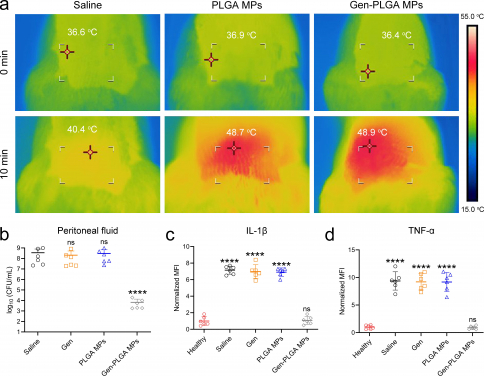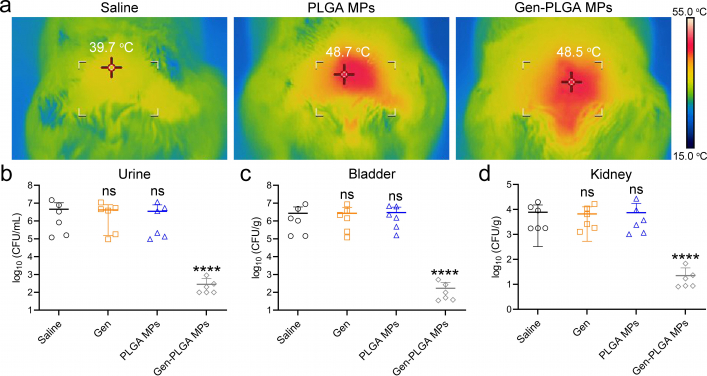Media
HKUMed designs a novel in-situ microwave hyperthermia therapy
to boost the efficacy of conventional antibiotics
by overcoming multidrug-resistant Escherichia coli infections
20 Jun 2022

Treatment efficacy:Peritoneal infection: a) Thermal images indicating the skin temperature over peritoneal location after injection with saline, PLGA MPs, and Gen-PLGA MPs after MWH irradiation for 10 min. b) MDR E. coli bacterial burden in the peritoneal fluid after different interventions. Obviously, the number of bacteria in Gen-PLGA MPs group has been significantly reduced. c–d) Quantification of the mean fluorescence intensity (MFI) of the expressions of IL-1β (c) and TNF-α (d) by immunofluorescence staining normalised to the mean of non-infected subject (Healthy). High expression of those cytokines can be observed in saline, gentamicin and PLGA MPs groups, whereas the group of gentamicin-loaded PLGA MPs bears no difference from the healthy controls.

Treatment efficacy:Urinary tract infection: a) Thermal images indicating the skin temperature over the bladder after injection with saline, PLGA microparticles (MPs), and gentamicin-loaded PLGA MPs (Gen-PLGA MPs), and microwave hyperthermal (MWH) irradiation for 10 minutes. b–d) MDR E. coli bacterial burden in b) urine, c) the bladders, and d) the kidneys after different interventions. It’s obvious that the group of gentamicin-loaded PLGA MPs after MWH can significantly reduce the bacterial load as compared with other groups.

Treatment efficacy:Peritoneal infection: a) Thermal images indicating the skin temperature over peritoneal location after injection with saline, PLGA MPs, and Gen-PLGA MPs after MWH irradiation for 10 min. b) MDR E. coli bacterial burden in the peritoneal fluid after different interventions. Obviously, the number of bacteria in Gen-PLGA MPs group has been significantly reduced. c–d) Quantification of the mean fluorescence intensity (MFI) of the expressions of IL-1β (c) and TNF-α (d) by immunofluorescence staining normalised to the mean of non-infected subject (Healthy). High expression of those cytokines can be observed in saline, gentamicin and PLGA MPs groups, whereas the group of gentamicin-loaded PLGA MPs bears no difference from the healthy controls.

Treatment efficacy:Urinary tract infection: a) Thermal images indicating the skin temperature over the bladder after injection with saline, PLGA microparticles (MPs), and gentamicin-loaded PLGA MPs (Gen-PLGA MPs), and microwave hyperthermal (MWH) irradiation for 10 minutes. b–d) MDR E. coli bacterial burden in b) urine, c) the bladders, and d) the kidneys after different interventions. It’s obvious that the group of gentamicin-loaded PLGA MPs after MWH can significantly reduce the bacterial load as compared with other groups.
- 1 / 2
- 2 / 2
A research team led by Professor Kelvin Yeung Wai-kwok from the Department of Orthopaedics and Traumatology, School of Clinical Medicine, LKS Faculty of Medicine, The University of Hong Kong (HKUMed) has designed a non-invasive technology to revitalise the bactericidal effects of conventional antibiotics in multidrug-resistant (MDR) Escherichia coli (E. coli)-associated deep tissue infections, such as urinary tract and peritoneal infections.
In the study, MDR E. coli bacterium was found to be sensitive again to the intervention of conventional antibiotics when the bacterium is exposed to mild hyperthermic condition (approximately 50 degrees Celsius). Hence, the HKUMed team designed a novel microwave-responsive microsphere encapsulated with conventional antibiotics that can realise the in-situ hyperthermia therapy and antibiotic treatment simultaneously. The outcome has been published in Advanced Functional Materials [link to publication].
Background
Among all the MDR bacteria, MDR E. coli, defined as Gram-negative bacterium, has been one of the three pathogens of concern with critical priority identified by the World Health Organization (WHO). Due to its unique outer membrane (OM) structure, the bacterium can immunise itself to the treatment of most antibiotics available in clinics. In brief, there is a particular barrier found in the structure, namely β-barrel assembly machine (BAM complex). When this complex combines with two other barriers MDR efflux pump and enzymatic degradation in cytoplasm, the bacterium can then effectively block off the attack of antibiotics. However, the conventional treatment can only weaken the function of BamA protein (main component of the BAM complex) instead of all the three barriers at the same time.
Research method and findings
The HKUMed research team has first discovered that these barriers will become paralysed temporarily if the infection site temperature is raised to about 50 degrees Celsius for only 10 minutes, in which this short-term and mild thermal treatment is tolerable by human tissues. When the conventional antibiotics can intervene at the same time, the team believes that the infection induced by gram-negative bacteria can be completely eliminated. Hence, they design a novel microwave-responsive microsphere comprising of FDA-approved biopolymer called poly(lactic-co-glycolic acid) (PLGA) that can generate mild heat subject to the stimulation of microwave signal. When this in-situ microwave hyperthermal (MWH) strategy is applied, it can effectively re-sensitise the MDR E. coli to conventional antibiotic treatments such as β-lactam, aminoglycoside, and tetracycline antibiotics. The results demonstrated that MWH has induced the structural turbulence of BAM complex, the functional obstruction of MDR efflux pumps, and the catalytic paralysis of related hydrolytic or modifying enzymes. Also, the treatment efficacy of this collective antibacterial strategy has been demonstrated in the animal models with urinary tract infection and peritoneal infection.
Research significance
‘We are inspired by the mechanism of fever in human body, when a human being combats bacterial infection. We then discover that the heat may help compromise the barriers built by MDR E. coli. When MWH combines with the use of commercially available antibiotics, this approach can remarkably diminish the burden of gram-negative bacterial infection (e.g. MDR E. coli) in deep tissues,’ said Professor Yeung. ‘We may also consider encapsulating the anti-tumour drugs together with antibiotics to treat bone cancer patients with post-operation bacterial infection in future practice.’
About the research team
This research study was led by Professor Kelvin Yeung Wai-kwok, Department of Orthopaedics and Traumatology, School of Clinical Medicine, HKUMed, in collaboration with professors from Peking University and Hebei University of Technology. The first author Mr Mao Congyang is a PhD student under Professor Yeung’s supervision.
Acknowledgments
This work was jointly supported by National Key R&D Program of China, Ministry of Science and Technology of the People’s Republic of China (R&D#2018YFA0703100); General Research Fund of Hong Kong Research Grant Council (Nos. 17207719 and 17214516), Health and Medical Research Fund from the Food and Health Bureau (Nos. 19180712, 20190422 and 21200592), Innovation and Technology Fund - Partnership Research Program (PRP/030/30FX), Innovation and Technology Commission, The Government of the Hong Kong Special Administrative Region; The National Science Fund for Distinguished Young Scholars (No. 51925104); Shenzhen Science and Technology Innovation Commission Funding (Nos. JSGG20180507183242702 and JCYJ20210324120009026); and Sanming Project of Medicine in Shenzhen - Team of Excellence in Spinal Deformities and Spinal Degeneration Diseases (SZSM201612055).
Media enquiries
Please contact LKS Faculty of Medicine of The University of Hong Kong by email (medmedia@hku.hk).
